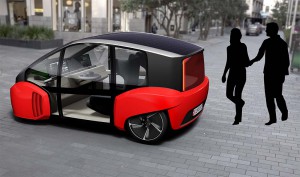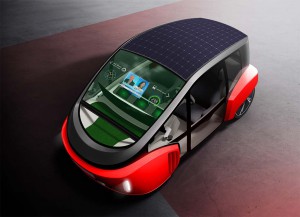We can always count on Switzerland’s Rinspeed to come up with a novel way to push the automotive envelope, and it plans to do that again. But rather than wait for the home show in Geneva, the edgy engineering house will bring its Oasis concept vehicle to the Consumer Electronics Show this January.
Rinspeed has, in recent years, focused on electric propulsion, and it’s now putting an increasing emphasis on autonomous vehicles. The Oasis is no exception. Despite its compact footprint, the concept offers a particularly roomy cabin, and that’s where it is designed, indeed, to be a mobile oasis.
“The interior offers a new living space with the ambience of a modern-day family room: armchair, sideboard, TV and a multifunctional steering wheel, of course,” explains a Rinspeed press release. “The windshield also serves as a screen for virtual as well as augmented reality.”
Though there’s still a steering wheel inside the Rinspeed Oasis, the concept has the look of a futuristic, driverless Uber-mobile. It reminds one, a bit, of the new Taxi of Tomorrow Nissan vans rolling out across Manhattan, especially with the huge amount of glass. Even the doors are transparent, but for the requisite crossbeams for crash protection.
It is meant to be “a lone voice in the wilderness,” says Rinspeed, “a bold statement against the notion of a city jungle requiring multi-ton SUVs for survival with this clever self-driving electric vehicle for the urban sphere.”
(Rinspeed reveals Ʃtos concept ahead of Geneva. Click Here for the story.)

The Rinspeed Oasis will make its debut not at the Geneva Motor Show, but at the Consumer Electronics Show this January.
Exactly who is the Oasis targeted at? Consider the general consensus is that we will soon be seeing a decline in private vehicle ownership in the globe’s fast-growing mega-cities. In fact, a number of those, including Paris, London, Beijing, even Helsinki, are already enacting or considering restrictions on personal mobility. Some cities are enacting access fees, others limiting access to zero-emissions vehicles, while still others want to ban automobiles entirely.
Lyft co-founder John Zimmer recently predicted private ownership will fade away over the next decade. But even if it doesn’t, the way we buy – and use – our cars could change drastically. When you consider that the average personal automobile is driven only an hour or so a day, why not find other uses during the rest of the day, Daimler AG CEO Dieter Zetsche asked last week during the Paris Motor Show debut of the Generation EQ concept.
Rinspeed suggests the Oasis could be a commuter car, or a “micro delivery vehicle” –or both. “Why move only people,” the company asks. That would seem perfect for the so-called sharing economy. You could program Oasis to take you to work and then go earn some money the rest of the day, whether through a ride-sharing service or, perhaps, delivering pizzas and packages for Amazon. There’s even a code-protected, heated or cooled drawer in the back of the Oasis.
(Click Here for details about the Rinspeed Budii.)
The good news is that when you do use it like a good, old-fashioned automobile, it would offer the height of comfort, with a living room-like ambience and access to endless amounts of media content on its built-in screens and augmented-reality windshield.
Power, of course, comes from an electric drivetrain, with a solar roof to boost range.
And the Rinspeed Oasis takes the concept of “green” one step further, the company notes, adding a “small green space for growing flowers or radishes below the windscreen. Urban gardening on wheels, so to speak.”
(Click Here for details about Obama’s commitment to zero traffic deaths.)
Don’t expect to see the Rinspeed Oasis go into production, any more than other recent concepts like the Budii, Ʃtos or Xchange. But some of the more intriguing elements just might influence automakers to adapt to their own products in the not-too-distant future.

